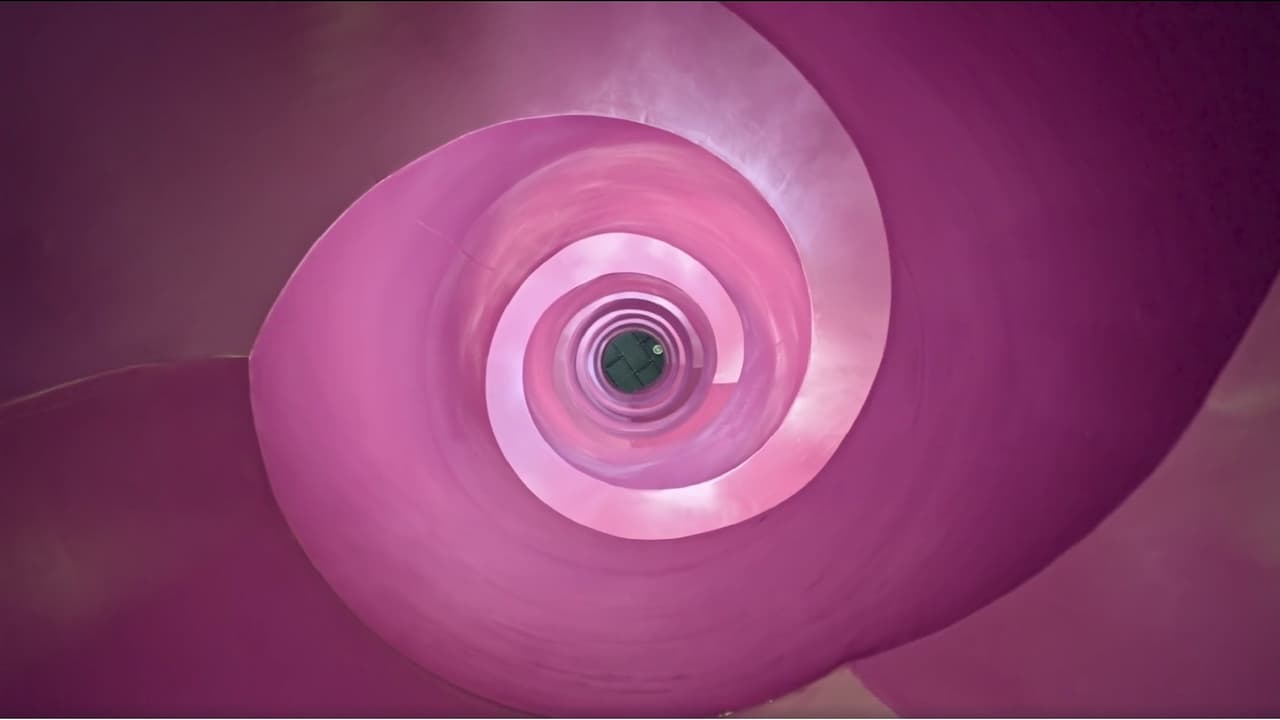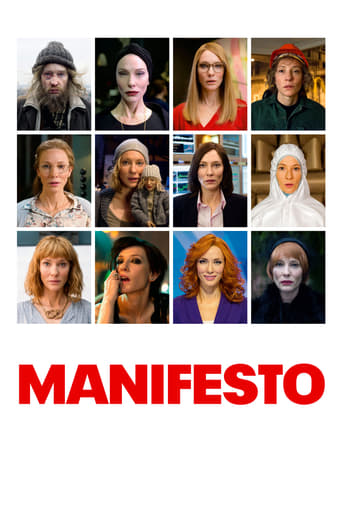



Not even bad in a good way
Good start, but then it gets ruined
Awesome Movie
Go in cold, and you're likely to emerge with your blood boiling. This has to be seen to be believed.
View MoreExcept this, eh...this flick reminds of my life long love of poetic logical jabberwocky...Cate Blanchett is such a treat and this flick is crazy creative fun as all get out...read anything into it or out of it...art schmartzie fartzie...a wonderful romp in the seriously ridiculous and wonderfully weird...silly seriousness...anyhow, Cate Blanchett is worth the entire show...this whole darn deal was done incredibly well...
View MoreI like Cate Blanchett as an actress basically, but I find the film pretentious, this is not done with the film language, there is no story in it. The work is an "art" itself, more like mixture of critical documentary and "experimental" poetry. Cinema may not be a good place to be shown, but the art gallery.
View MoreManifesto is a manifesto about the ambition and limitations of artists' and philosophers' manifestos about art. Call it an anti-manifesto.In their setting and delivery most of the theories about art-making here are presented lightly, ironically. Their earnestness is especially amusing,Perhaps the one exception is the first. The Trump presidency — especially in the week of the Houston floods — gives an electric currency to Karl Marx's declaration of the deadliness and death of capitalism and the call for artists to lead a revolution. The film is framed by the Marxist call to arms and the final manifesto, an antithetic preference for tradition over individual imagination that turns restrictive.Still, that last episode provides the clearest representation of the beauty of life and the danger of restrictive art theory. Perhaps the film's most touching image is the tracking shot along the Grade III students' faces at their desks, especially the first three girls with their insecurity, uncertainty, fear. They are the future for which all the manifestos intend to prepare. The teacher assigns their film-scripting with a license to steal their ideas from anywhere. She cites Godard: "It doesn't matter where you take things from, but where you take them to." She seems thus to give her charges total freedom for their creativity. But as she visits each student's project she drops another restriction. No props are allowed. You must use fixed lighting. The director may not be named. Like every manifesto, her every specific direction is a restriction, not a freeing. The students' real "liberation" comes when they're freed from their ostensibly "creative" class. Now the camera pans across the schoolyard where the children break into play, some in pairs or groups, some by themselves. They run free and physical, poised by slow-motion for our reading, Again the individual face is a rich encapsulation of life, the human condition, at its purest, most hopeful, most vulnerable. As an emblem of these liberated spirits the film catches the schoolyard pigeons fluttering into the sky in slow motion. That film device is as pure as the children's faces, the artistic strategy that does what art should do — whatever the school or manifesto — illuminate our state of living and free the imagination. Aptly, the film about art presents its own statement on art in a situation of restrictive theory on film — with liberation in film's unique capacity to reveal what is normally lost in the flux of time and life. It lets us SEE what we'd normally miss. The various theories of art are wittily dramatized. Dadaism is propounded as a funeral sermon. The chicken soup and domestica associated with Pop Art lead to that manifesto recited as a suburban mother's grace at a lunch table, the father and sons burdened with the interminable inventory of Pop principles. There are three emblems of Pop's withdrawal from nature. The family dog is twice brought to its food — and twice leaves it! The living room is defined by a variety of stuffed wildlife, including an adult black bear, and a live crow. At the table the mother pours gravy on the desiccated duck the dad carves. So too the urban settings are generally monstrous, dehumanizing, or in ruins. Vorticism and abstract expressionism are propounded in a glitzy ultramodern estate by a chic CEO type. Conceptual art — where what counts is the idea not the realization — is presented as a TV news dialogue between shiny anchor Cate and rain drenched street reporter Cate. Naturally, the rain is fake. Punk aesthetic is as deadhead, dead-end and self-destructive as the stoned party folk. The stock brokerage, factory, garbage dump and the martinet directing a robotic alien ballet scene equally show art responding to dehumanizing modernity but with their own destructive rigidities. For the surrealist ethic Cate Blanchett speaks to/through a puppet of herself, an apt image of the merging of the real and the dream worlds. The doll springs to pained life when Blanchett sticks pins into its/her head to secure the wig. Whatever the theory, the power of art inheres in its visceral impact. We know it's a doll but the "art" is so true we wince.
View MoreThe Manifesto is a German artist Julien Rosefeldt, played by Cate Blanchett's 13 different characters. Each character that Blanchett spots plays and sings passages from different manifestos. It's obviously a hard-to-follow, hard-core movie.Still, the film has a fluent narrative. Rosefeldt identifies each character with a manifesto. It is possible to say, "What does he mean?" As the words flow rapidly. Because the content needs to be placed in a context and doing so is not possible because of the "difficult to follow" that I am talking about.Although this situation reduces the pleasure of the film, it is not disconnected from the narrative that it reveals in general terms. Blanchett offers a one-man show. He did not portray his characters as if he had lived / lived. In parallel, I can say that atmosphere, make-up and fiction are also top level. It is also worth noting that the manifestos associated with Blanchett's performance, or the humor that he created about the contents ...
View More